Estudio experimental de la articulación de rodilla canina sometida a translación cranial de la tibia: comparación entre la rodilla intacta, con LCA deficiente y con la ATT.
Fecha
2019Palabras Clave
Ligamento, Biomecánica, Articulación de la rodilla canina, Prótesis ortopédicas, Avance de la tuberosidad tibialLigament, Biomechanics, Canine stifle joint, Orthopaedic plates, Tibial tuberosity advancement
Metadatos
Mostrar el registro completo del ítemResumen
El avance de la tuberosidad tibial (ATT) constituye una técnica usada para reparar la articulación fémoro-tibio-patelar (de la rodilla) después de una lesión de rotura del ligamento cruzado cra-
neal (LCCr). El objetivo de este estudio fue comparar la rigidez (es decir, la fuerza entre desplazamiento) de la articulación de la rodilla intacta respecto a la misma después de seccionar el LCCr y de aplicar la técnica de reparación del ATT. El desplazamiento craneal de la tibia respecto del fémur se simuló en ensayos experimentales mediante el desplazamiento caudal del fémur respecto de la tibia fijada. Esta fuerza tangencial fue aplicada en 8 articulaciones fémoro-tibio-patelares (in vitro) obtenidas de perros adultos con un rango de pesos de 25 a 30 kg. Los valores
de fuerza y desplazamiento registrados se usaron para calcular y comparar rigideces (en Newton/mm). Después de seccionar el LCCr, el desplazamiento incrementó 3,8 veces y la rigidez decre- ció 76% respecto a la articulación de la rodilla intacta. El valor de rigidez en la articulación de la rodilla sana no fue alcanzado después de la intervención con el dispositivo de la ATT, pero el desplazamiento se redujo a la mitad y la rigidez se duplicó, com- parada con la articulación de la rodilla con el LCCr deficiente. La técnica de la ATT no frena complentamente el desplazamiento craneal de la tibia respecto al fémur, sin embargo, el valor de la rigidez de la articulación de la rodilla reparada duplica el valor de la rodilla con LCCr deficiente.
Colecciones
Información Adicional
| Otros Títulos | Experimental Study of Canine Stifle Joint Stiffness Under Cranial Tibial Translation: Comparison Between the Intact, the ACL-Deficient and the TTA Knee |
| Correo Electrónico | elsa.perez@upc.edu |
| Editor | SaberULA |
| ISSN | 0798-2259 |
| ISSN Electrónico | 2477-944X |
| Resumen en otro Idioma | The tibial tuberosity advancement (TTA) is used to repair the knee after anterior cruciate ligament (ACL) rupture. The aim of this study was to compare the stiffness (i.e. force per displacement) of the intact knee to that of the same knee after ACL section and after applying the TTA repair technique. The cranial displacement of the tibia relative to the femur was simulated in experimental trials by applying a caudal displacement of the femur on a fixed tibia. This tangential force was applied on 8 femorotibial joints (in vitro) obtained from adult dogs weighing between 25 and 30 kg. The recorded force and displacement values were used to calculate and compare stiffnesses (in Newton/millimeters). After sectioning the ACL, the displacement was 3.8 times higher and the stiffness decreased by 76% compared to the intact knee. The healthy knee stiffness value was not reached after repairing the knee with the TTA device, but displacement was halved and stiffness doubled compared to the ACL-deficient knee. The TTA device does not completely stop the anterior displacement of the tibia relative to the femur; however, the stiffness value of the repaired knee doubled that of the ACL-deficient knee. |
| Colación | 141-147 |
| País | Venezuela |
| Institución | Universidad del Zulia (LUZ) Universidad de Los Andes (ULA) |
| Publicación Electrónica | Revista Científica |






